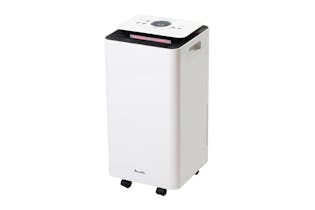How to choose the best dehumidifier
Ready to buy a dehumidifier? Compare dehumidifier reviews to find the best dehumidifier for your home. We discuss the different types of dehumidifiers and features to look for when choosing a dehumidifier.
What does a dehumidifier do?
Airborne moisture can damage your home and pose a risk to your health. A dehumidifier removes excess moisture from the air to help keep your home drier, healthier and less prone to mould.
Check our dehumidifiers test results to see how they really perform over a Kiwi winter.
Types of dehumidifiers
There are two types of dehumidifiers: desiccant and refrigerant (compressor). Most dehumidifiers available here are refrigerant models, but there are increasing numbers of desiccant dehumidifiers in the market.
How does a dehumidifier work?
Refrigerant dehumidifiers use the same technology as heat pumps and fridges. They draw in damp air, condense the moisture into water that’s collected in a tank, then warm and release the dry air.
Desiccant dehumidifiers suck air through a rotating disk containing moisture-absorbing material. The disk is heated to release the moisture, and this vapour is condensed into water and collected in a tank.
Desiccant dehumidifiers typically perform better than refrigerant models in temperatures below 12°C. But desiccant dehumidifiers can cost three times more to run.
Dehumidifier features
Consider these features when buying a dehumidifier.
Energy efficiency
The energy efficiency scores in our dehumidifiers test indicate how much energy the dehumidifiers use to extract moisture from the air. A higher score means the dehumidifier uses relatively less energy.
We also calculate the daily running costs based on 8 hours of continuous use. Costs range from 27¢ to $1.64 per day.
Check our test results to compare dehumidifier energy usage.
Humidistat
Like a thermostat for relative humidity, dehumidifier humidistats let you set desired humidity levels. The dehumidifier will work until the room reaches the set level. Removing too much moisture from the air can result in dry skin, throat and eyes. We recommend 30%–50% humidity to keep dust mites to a minimum and reduce the growth of mould and bacteria.
Timers
A timer allows you to set the times a dehumidifier will switch on and off. If a dehumidifier doesn’t have a timer, you can use an inexpensive wall plug timer.
Noise and fan speeds
Most dehumidifiers make 50 decibels (dBA) or more of noise. That’s enough to be annoying if you’re watching TV. For comparison, a reasonably quiet fridge produces about 40dBA.
In our test, we record which dehumidifiers are quietest. We also note how many fan speeds each dehumidifier has – you can reduce noise by turning down the fan on models that have an adjustable fan.
Tank size
What size dehumidifier do you need? A small water collection tank makes a dehumidifier light and compact, so it’ll be easy to move around. Smaller tanks are also easier to lift to a sink to empty than those of larger dehumidifiers. But the smaller the tank, the more often you’ll have to empty it. In our testing, we measure tank capacity to shut-off.
As an alternative to manually emptying your dehumidifier’s tank, you can plumb it with a hose for continuous drainage. This is a good option for larger models.
Wheels and carry handles
Wheels and carry handles make your dehumidifier easier to move around the house. Larger models can weigh over 20kg, so look for wheels when buying a large dehumidifier.
Compare dehumidifiers in our test results to see which models have the features you want and which have the best moisture extraction rates.

Could your next power bill be smaller?
Powerswitch is the free, independent way to check your power plan, and see if you could save - backed by Consumer NZ. So why pay more than you need to? Check in just 3 minutes - and make sure you know the deal.
We've tested 22 dehumidifiers.
Find the right one for you.
AusClimate

AusClimate
.jpg&w=315&q=75)
